An electric convector with a thermostat is a heating equipment that maintains a given temperature in the house. The built-in electronic thermostat allows you to precisely regulate the heat with a deviation of 0.1-0.30C. Thanks to its beautiful design, safety and efficiency, a modern convector with an electronic thermostat deserves the attention of the consumer.
Varieties
Among the main types of convectors with an electronic thermostat, the following devices are distinguished:
- Wall-mounted. The most common type of heating equipment. When using this technique, warm air accumulates at the top and cold air at the bottom. With high ceilings, uneven distribution of air flow will be a significant disadvantage.
- Floor-standing. Mobile equipment is used as an auxiliary heating device.
- In-floor. Convectors of this type are designed for use in office and residential premises where strong noise or design solutions prevent the use of devices with forced convection. The equipment is perfectly compatible with underfloor heating systems. In-floor electric convectors are made with corner connections, arc-shaped, wave-shaped, with a roller or linear grid. The heating duct comes in different sizes and is made of granite, marble, wood. Disadvantages include the high price and complex installation of the device.
Trench electric convectors
How to choose the right device
Knowing the advantages of the device is half the battle. Manufacturers produce a wide variety of models that have different power, dimensions, and functions. Products differ from each other regardless of the same purpose. And therefore, we will highlight several points that will help you make the right choice.
How to calculate the number of devices
The main parameter here is the power of the equipment that needs to be determined to heat the room.
The following data will be required:
- room area;
- ceiling height;
- number of floors;
- whether other heating devices are installed.
Results may vary depending on other features: whether there are double-glazed windows in the room, what kind of thermal insulation is installed.
In our conditions, a heating device on average has a radiated power of 1 kW per 10 m2. Even if there is severe frost outside, this will allow you to warm the room to +18...+20 degrees Celsius. With a room area of 20 m2, the required power is calculated as follows: 20: 10 x 1 kW = 2 kW. When making calculations, it is recommended to start from the minimum indicators, which will allow you to maintain the so-called power reserve.
This formula is relevant for rooms without double-glazed windows with one outer wall. If the room is corner, heating 10 m2 will require 1.3 kW of power. Installed double-glazed windows can reduce heat losses by 25%.
We select the convector by length
The devices are capable of not only heating rooms, but also acting as a thermal curtain. Stained glass windows and entrance areas are those places where cold is always present, and it is the convector that allows it to be leveled out. It is important that it has a length of 75–90% compared to the width of the window.
Availability of a fan
Manufactured convectors come with natural and forced convection. As for the former, such models do not provide a fan, so the equipment is more suitable for small rooms and as an additional heat source. Devices with forced convection, that is, with fans, are more suitable for large rooms. They are used as the main or additional heat source.
Device Features
The structure of the electric convector will differ depending on the type of heating equipment. The design of a wall-mounted electric heater consists of the following components:
- device body;
- heating element (heating element);
- off/on buttons;
- cord with plug;
- thermostat;
- grille with guide curtains for air outlet;
- thermal fuse that protects against overheating;
- tilt sensors and protection against foreign object penetration (additional options that depend on the model).
The design of the electric heater built into the floor is somewhat different and includes:
- decorative frame profile;
- roll-type grille made of anodized aluminum;
- high-performance convector;
- EC fan;
- protection against twisting in the wire connection unit;
- mounting feet for height adjustment.
Note! Convectors with an electronic thermostat are designed to heat residential premises with an optimal level of humidity. Do not use the device in swimming pools. Models with appropriate protection are marked IP24.
How to choose an electric convector with an electronic thermostat and control for your home
Among all heating methods, convection occupies one of the leading positions. These devices are popular due to their efficiency and affordable price. The most convenient to use are convectors with an electronic thermostat, which provides ample opportunities for controlling this heating equipment.
What are electric convectors with an electronic thermostat?
An electric convector with an electronic thermostat is a device for heating rooms that allows the user to set the desired air temperature. There are models that provide for the replacement of a mechanical thermostat with an electronic one. Modern modifications of these devices have a display that displays the set and actual air temperature.
What is it for and where is it used?
An electronic thermostat is a device that regulates the degree of heating of the heating element, which is the main design component of the converters. The temperature of the heating element and the environment is monitored using special sensors.
Electronic thermostats are used in heating, air conditioning, and autonomous water supply systems, ensuring a comfortable microclimate in rooms for various purposes. Necessary for maintaining the required temperature in refrigeration units at work and at home, in mobile refrigerators. Widely used to create optimal conditions for growing plants in greenhouses and winter gardens.
How it works: device and principle of operation
The very name of the device “thermostat” indicates its functions:
- temperature tracking;
- its stabilization.
Structurally, it consists of several elements:
- temperature sensor (measuring component);
- controller (regulating component);
- contact Group.
In temperature control, the main role is played by a thermocouple, which is two dissimilar conductors soldered into a single unit.
When one of them is heated, a voltage arises that is directly proportional to the temperature difference. The signal is processed by the controller and a command is issued to decrease or increase the degree of heating of the heating element.
There are two main categories of electronic thermostats:
- analog;
- digital.
The first allow you to set the desired temperature range or the exact temperature. These are the simplest devices to use, inexpensive, with intuitive settings. Equipped with a display.
Digital - programmable devices of two types:
- with closed logic;
- with open
The former are distinguished by a constant operating mode specified by the manufacturer. Program correction is not possible; only temperature indicators and other basic settings can be changed.
Digital thermostats with open logic are more flexible in control. They have a wide range of settings and are most often installed on industrial-type devices.
Necessary when creating a network of heating devices, installed on the leading one.
Installation methods: which is better?
The method of installing an electronic thermostat directly depends on its design features. Devices for adjusting the temperature of convectors are built-in and for their installation it is necessary to provide access to the internal space of the housing.
The wide variety of models of these devices does not make it possible to provide step-by-step instructions for installing an electronic thermostat. But the essence of the work is to replace one control unit (already installed on the heating equipment) with another, in accordance with the connection diagram of this model.
Reviews of heating convectors with an electronic thermostat: pros and cons
A large number of reviews about convectors with an electronic thermostat make it possible to identify all the strengths and weaknesses of this equipment.
Pros:
- wide range of adjustments;
- variety of housing styles;
- efficiency;
- high accuracy of setting the desired temperature;
- the ability to find out the set and actual air temperature;
- safety of operation.
Minuses:
- higher price than models with mechanical control;
- On some devices the relay operates loudly.
Manufacturers and popular models: ranking of the best and prices
The climate equipment market is replete with a variety of convectors from different manufacturers. For those who decide to install these devices for the first time, it is not easy to understand their extensive range. A review of the best models from leading brands will provide significant assistance.
NOIROT SPOT E-5 1000W
The SPOT E-5 series features a modern control system with numerous operating mode settings.
The SPOT E-5 1000W model has a maximum power of 1 kW and is equipped with an electronic thermostat with an LCD display. The device operates on the principle of natural convection, is silent and efficient. The design provides protection against voltage surges, overheating and overturning. The convector has II electrical protection and does not require grounding. The splash-proof design of the housing allows you to install the equipment in rooms with high humidity.
Specifications:
- recommended heating area - 10 m2;
- 3 operating modes;
- dimensions - 420x420x80 mm;
- weight - 3.6 kg.
Average price 6999 rub.
Heater BALLU BEC/EZER-1500
Floor convector with electronic control unit. Wall mounting is possible, for which the manufacturer has provided special brackets (included in the package). The expressive style of the case was developed by an Italian design bureau. A durable monolithic x-shaped heating element is installed. Several functions have been implemented:
- parental control;
- protection against overheating and capsizing;
- restart during power outages, restoring the latest settings.
Specifications:
- recommended heating area - 20 m2;
- 2 operating modes;
- maximum power - 1500 W;
- dimensions - 400x830x113 mm;
- weight - 3.6 kg.
Average price 3890 rub.
ATLANTIC F117 DESIGN 1000W PLUG
One of the best wall convectors with an electronic thermostat. A distinctive feature of the equipment is a heating element with a large-area aluminum radiator, which ensures rapid heating of a significant volume of air. Built-in electronic thermostat with control wire. There is a power indicator on the front panel. The functions of auto shutdown in case of overheating and overturning, and anti-freezing are implemented.
Specifications:
- recommended heating area - 15 m2;
- 2 operating modes;
- maximum power - 1500 W;
- dimensions - 451x458x98 mm;
- weight - 3 kg.
Average price 3900 rub.
Heating device ROYAL CLIMA REC-M1500E Milano elettronico
The convector is equipped with a highly efficient, reliable X-shaped heating element X-ROYAL Long Life Heater, characterized by an increased heat exchange area. Guaranteed quick access to operating mode within 10-20 seconds. The stainless steel body is easy to use and has no sharp corners. The convector is equipped with roller legs with a stopper. There is protection against overheating and tipping over.
Specifications:
- recommended heating area - 15 m2;
- maximum power - 1500 W;
- dimensions - 400x610x92 mm;
- weight - 4 kg.
Average price 3640 rub.
VITEK VT-2151(W)
Compact floor convector for heating rooms up to 20 m2. The maximum heating temperature of the case is 60°C. It is characterized by noiselessness and quick access to operating mode. The built-in timer allows you to set the device shutdown time. The functions of child protection, anti-freezing and automatic shutdown in case of overheating and overturning are implemented. There is a light indicator of work.
Specifications:
- power - 750/1500 W;
- weight - 5.18 kg.
Average price 2790 rub.
Convector ELECTROLUX ECH/B-1000 E
This convector is one of the latest developments from the manufacturer, which uses innovative technologies. The body of the device is made of black heat-resistant glass, which is highly resistant to mechanical stress. Features highly efficient heat transfer. Wall installation and floor operation are possible. There is protection against overheating and tipping over.
Specifications:
- recommended heating area - 15 m2;
- maximum power - 1000 W;
- dimensions - 600x480x75 mm;
- weight - 8 kg.
Average price 5210 rub.
Floor heater REDMOND RFH-C4519S
New for 2015, with the possibility of remote control from a smartphone or tablet, as well as via remote control. The convector is equipped with a monolithic ceramic heating element, which guarantees long and silent operation. The device is equipped with a removable filter for air purification and an LED power indicator. There is protection against overheating and tipping over.
Specifications:
- recommended heating area - 20 m2;
- maximum power - 2000 W;
- dimensions - 157x480x408 mm;
- weight - 3.4 kg.
Average price 7799 rub.
Which manufacturer and which type is better to choose: TOP-3
The best convectors are produced by companies specializing in the production of climate control equipment. The leaders in this market segment are NOIROT, BALLU, ATLANTIC, ROYAL, ELECTROLUX.
Calculation of the minimum required power
It is easy to find out the required power of the convector. To do this, you need to remember the calculation principle: for every 10 m2 of heated area, 1 kW of thermal energy is required. In accordance with this, for a room of 25 m2, a device of 2-2.5 kW is required.
What else to consider when choosing a device?
Most often, when choosing a convector, they focus on two parameters: power and design. But it is equally important to consider the presence of operating modes that allow you to save energy. Pay attention to the degree of protection of the device. It is necessary that it has auto-shut-off functions for overheating, tilting and tipping over.
3 best models
Of the entire range of electronically controlled convectors, three best models can be distinguished:
- NOIROT SPOT E-5 1000W — 6999 RUR;
- ELECTROLUX ECH/B-1000 E — 5210 RUR;
- BALLU BEC/EZER-1500 — 3890 rub.
Price
Pricing is a complex procedure that each manufacturer considers differently. When determining the cost of a convector, they take into account the type of heating element, the number of modes, the ability to program operation, and the availability of additional options.
Budget models can be bought for 2000-4000 rubles:
- BALLU BEC/EZER-1500 — 3890 RUR;
- ATLANTIC F117 DESIGN 1000W PLUG — 3900 RUR;
- ROYAL CLIMA REC-M1500E Milano elettronico — 3640 RUR;
- VITEK VT-2151(W) — 2790 rub.
The price for models with wider functionality starts from 5,000 rubles:
- NOIROT SPOT E-5 1000W — 6999 RUR;
- ELECTROLUX ECH/B-1000 E — 5210 RUR;
- REDMOND RFH-C4519S — RUR 7,799
Where to buy an electric convector with an electronic thermostat for an apartment or house?
In Moscow
- "Artclimate"; st. Elektrozavodskaya, 24; 8 (495) 645-86-22.
- MirCli; Leningradsky Prospekt, 80, building G; 8 800 775-22-19.
- "ClimatProff"; Dmitrievsky, 7;.
In St. Petersburg
- "Elcom"; Vitebskaya Sortirovochnaya street, 34 Zh; 8 (812) 320-88-8
- "Climate Technologies"; emb. Obvodny Canal, 64; (812) 655-50-77.
- "GoodClimate"; Serpukhovskaya, 34; +7(812)34-000-36.
Convectors with an electronic thermostat are superior to devices with mechanical temperature control in all respects. Modern models are always more impressive in appearance and more convenient to use.
Apr 20, 2018ventsyst
Principle of operation
electronically controlled convector is based on the circulation of air masses at different temperatures. Inside the device there is a heating element, on the surface of which there are holes. Thanks to the lower compartments, cool air flows freely into the device and is heated by the heating element. Afterwards, the heated masses rise and exit back through the blinds at the end of the convector.
The heating element in the technique is a tubular heating element, which is made of a special alloy. The material is heated to a certain temperature, and after a while the room becomes warm.
The principle of natural convection allows for high efficiency of heaters of this type - from 90% and above. This means that electricity is used sparingly without a large percentage of heat loss, going only to heating the air.
Operating principle of the convector
Features and purpose of the electronic thermostat
The thermostat is installed in both expensive and budget models. Its main task is to maintain a certain temperature at a given level. The device consists of a plastic housing on which an electronic display is installed. The thermostat can be made with a scale in degrees and an LED. The backlight allows you to use it in poor lighting. The display shows: the values of the set temperature and operating mode, the selected program, and the percentage of battery charge.
Electrolux ECH AS-1500 ER
Next in our review is the Electrolux ECH AS-1500 ER electric convector. This convector has a digital display equipped with a high-precision electronic thermostat that maintains the optimal room temperature with an accuracy of 0.1 degrees.
The convector is equipped with two operating modes. This helps to effectively warm up the room in a short time or heat it evenly, while spending a minimum of energy.
On the bright display, in addition to the power-on indication, you can find information about the current and set room temperature and the operating mode of the device.
The convector is reliably protected from freezing. It turns off when it overheats, which helps avoid damage to the device. Child lock locks the screen, so only an adult can make changes to the current settings.
- type - convector;
- control - electronic;
- heating power 1500 W
- thermostat
- number of operating modes: 1
- overheat shutdown
- installation: wall, floor
- heating element type: monolithic
- dimensions - 59.50x40x9.70 cm;
- weight - 4 kg.
Installation methods
There are 3 options for installing the device.
- Wall mounting. A wall under the window is chosen for it, preventing fogging and drafts.
- As a freestanding heating equipment.
- Installation of a built-in convector in the floor. A huge disadvantage of this option is that installation is carried out during the repair of the coating.
Correct installation is the key to safety, long service life of an electronically controlled convector and correct operation of the thermostat. When installing on a wall, observe the distances indicated in the diagram:
- from the floor to the convector no less than 80mm;
- from the top of the case to the ceiling or window - at least 120 mm;
- from the side to the wall - at least 50 mm.
Installation of a wall-mounted electric convector
Advice! Please read the instructions carefully before installation. This will protect against problems in the operation of the device.
Methods for installing a floor convector
In general, floor-standing models are quite easy to install. The only thing you should pay attention to is the correct supply of coolant. As for the rest, the device plays the role of a regular heater installed in any convenient place. There are models that only require power supply, and they can be installed anywhere - in any room where additional heating is needed.
The installation procedure includes the following steps.
- Marking . The installation locations of the device and routes for laying communications are displayed on the floor surface.
- Coolant supply . If it is water, then pipes must be laid to the convector accordingly. If the heating system is installed in a new building, work should be carried out before finishing.
- Installation . It is better if the convector has a separate line from the riser through which hot water will flow. If previously there were classic radiators in the room, new electric convectors are connected to the existing circuit.
- Leveling the floor . The equipment must be installed parallel to the floor. A special grille is installed on top, playing a decorative role. The convector itself is placed in a horizontal position.
As you can see, installing this type of heating equipment is not difficult.
Wall-mounted models are more difficult to install - you need to adjust the brackets correctly. Communications have to be laid in a hidden way so that the device does not spoil the interior. Study the cast iron heating stove at the link.
Advantages of the device
When choosing an electric convector with a thermostat, pay attention to the following advantages of the device:
- Environmentally friendly. When heating a room, no harmful substances are released into the space, the air does not dry out and is not burned.
- Easy to install. When installing on a wall, you will need to drill several holes as shown in the instructions.
- High efficiency.
- Electronic control.
- The presence of a thermostat.
- Long service life. The average lifespan of the device is about 20 years.
- Silence. The device operates without a fan or pump, so it does not create unnecessary sounds.
- Price. From a diverse range, you can choose models that cost no more than convectors without a thermostat.
- Safety. It is not the housing that heats up, but the heating element. The device has no sharp corners.
Proper care of the device
To keep the performance in working order, use our tips:
- Regularly wipe the top and bottom openings of the blinds with a damp cloth;
- It is recommended to use a vacuum cleaner to remove dust from the grilles;
- do not dry clothes on the appliance;
- make sure that the curtains do not block the air openings on the outer surface of the device;
- When the electric convector is idle, to prevent dust and insects from entering, wrap the device in a plastic bag.
Advice! Do not partially or completely overlap parts of the grilles to avoid damage.
Choosing an electric convector with a thermostat
To choose the right option, pay attention to the following characteristics.
- Size. If the convector is installed under panoramic windows, choose a height of 230-300 mm. The standard size of the device is 400-450 mm.
- Thermostat type. Choose electronic control: the heater is resistant to temperature changes, accurate and silent.
- Installation method. If the convector is planned to be hung on the wall, the kit should include mounting brackets. For placing equipment on the floor, a model with wheels is the best option.
- Power. This parameter depends on the heat losses in the room, mode and season of operation.
Note! If a small child lives in the house, then a wall-mounted model is the preferred option. It has no sharp corners, does not turn over and there is no possibility of getting burned.











